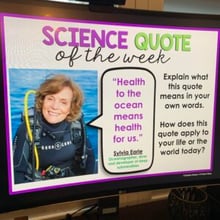Hurricanes Activities for Middle School Science
The resources below will provide students a comprehensive understanding of hurricanes. All of the following lessons are also included in the Kesler Science Membership.
The Hurricanes 5E Lesson includes materials for every "E" phase, including the Hurricanes Station Lab for Exploration and an interactive PowerPoint with digital INB templates for Explanation.
The lesson also includes introduction materials for Engagement, student-choice project ideas for Elaboration, and assessments for Evaluation.
After completing Hurricanes 5E lesson, students will be able to identify the role of oceans in the formation of weather systems such as hurricanes.
The Hurricanes Inquiry Lab is a hands-on activity that is differentiated for advanced, on-level, and modified middle school students.
Students will track the pathway of some of the most famous hurricanes in history and draw conclusions about hurricane formation and travel based on patterns they identify in their map.
The Hurricanes Inquiry Lab includes a brief reading passage, comprehension checks, hands-on activities, reflection questions, and a CER conclusion.
The Hurricanes Sub Plan is a complete lesson that takes students through a warm-up, reading passage, independent activity, extension activities, and an assessment.
The worksheets are designed to make your sub day a breeze for you, your students, and the substitute teacher. They are also perfect for distance learning.
Hurricanes Classroom Experiences
Create a powerful student experience to help solidify students' understanding about hurricanes. The following experience is also included in the Kesler Science Membership.STEM CHALLENGES
The Project: Hurricane Defender - Build a Hurricane Proof House STEM Challenge uses the engineering design process to design a house that can withstand hurricane force winds, yet still appeal to homeowners. You will have to be budget conscious with your design and have a house strong enough to stand up to the deadliest hurricanes.
Students will be using collaborative skills such as brainstorming with their peers and reflecting on their progress during the project.
At the end of the Project: Hurricane Defender - Build a Hurricane Proof House STEM Challenge, students are given an opportunity to share their projects outside of the classroom.
Year-Round Resources
These year-round activities will increase your students' understanding of many middle school science topics. All of these activities are also included in the Kesler Science Membership.
Visual Data & Graphing
You're not alone if your students struggle with understanding graphs, charts, and tables. It's a skill that takes an enormous amount of practice. This resource will help students build a strong foundation in analyzing data and creating their own data visualizations.
Bell Ringers and Warm-Ups
These middle school science bell ringers are an excellent way to engage your students as soon as they walk into your classroom. This comprehensive FULL YEAR resource includes everything you need to start off each science class with an interesting warm-up activity.
Review Board Games
Each game board has been carefully designed to keep students engaged. There are 10 different action spaces on each board and dozens of question cards. All of the actions are related to science concepts and keep the students motivated throughout the game.
Each game is ready to play. Simply print out the board and the cards and let the students enjoy reviewing nine different units.
Essential Questions and Standards
Below are the essential questions and standards associated with the lessons and activities included in the hurricanes unit. This topic is only one of more than 100 middle school science topics included in the Kesler Science Membership.
-
What part do oceans play in the formation of weather systems such as hurricanes?
-
How are hurricanes formed, measured, and tracked?
-
MS ESS2-6 - Develop and use a model to describe how unequal heating and rotation of the Earth cause patterns of atmospheric and oceanic circulation that determine regional climates
-
MS ESS3-2 - Analyze and interpret data on natural hazards to forecast future catastrophic events and inform the development of technologies to mitigate their effects
-
TEKS Science 8.10 C - Identify the role of the oceans in the formation of weather systems such as hurricanes
Kesler Science Membership
Imagine never having to search for another middle school science lesson again. The membership gives you access to ALL of the Kesler Science products in one place (Yes, including everything above).
Say goodbye to long hours of lesson prep.


